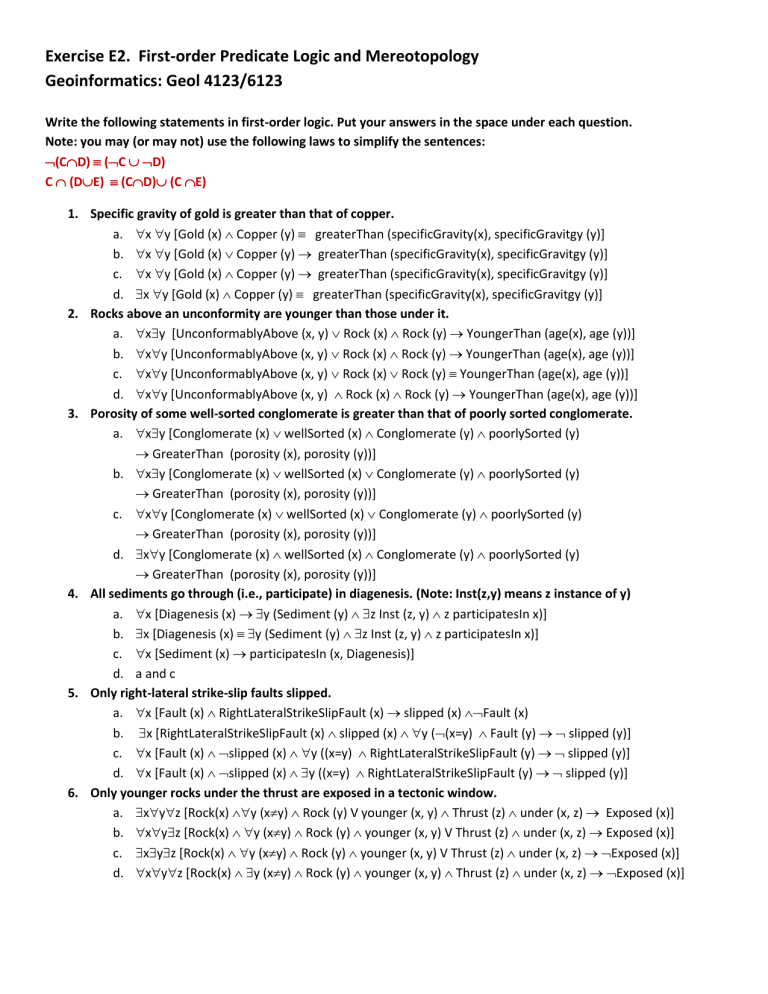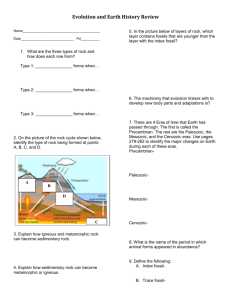E2_logic_mereotopolo..

Exercise E2. First-order Predicate Logic and Mereotopology
Geoinformatics: Geol 4123/6123
Write the following statements in first-order logic. Put your answers in the space under each question.
Note: you may (or may not) use the following laws to simplify the sentences:
(C
D)
(
C
D)
C
(D
E)
(C
D)
(C
E)
1.
Specific gravity of gold is greater than that of copper. a.
x
y [Gold (x)
Copper (y)
greaterThan (specificGravity(x), specificGravitgy (y)] b.
x
y [Gold (x)
Copper (y)
greaterThan (specificGravity(x), specificGravitgy (y)] c.
x
y [Gold (x)
Copper (y)
greaterThan (specificGravity(x), specificGravitgy (y)] d.
x
y [Gold (x)
Copper (y)
greaterThan (specificGravity(x), specificGravitgy (y)]
2.
Rocks above an unconformity are younger than those under it. a.
x
y [UnconformablyAbove (x, y)
Rock (x)
Rock (y)
YoungerThan (age(x), age (y))] b.
x
y [UnconformablyAbove (x, y)
Rock (x)
Rock (y)
YoungerThan (age(x), age (y))] c.
x
y [UnconformablyAbove (x, y)
Rock (x)
Rock (y)
YoungerThan (age(x), age (y))] d.
x
y [UnconformablyAbove (x, y)
Rock (x)
Rock (y)
YoungerThan (age(x), age (y))]
3.
Porosity of some well-sorted conglomerate is greater than that of poorly sorted conglomerate. a.
x
y [Conglomerate (x)
wellSorted (x)
Conglomerate (y)
poorlySorted (y) b.
GreaterThan (porosity (x), porosity (y))]
x
y [Conglomerate (x)
wellSorted (x)
Conglomerate (y)
poorlySorted (y)
GreaterThan (porosity (x), porosity (y))] c.
x
y [Conglomerate (x)
wellSorted (x)
Conglomerate (y)
poorlySorted (y)
GreaterThan (porosity (x), porosity (y))] d.
x
y [Conglomerate (x)
wellSorted (x)
Conglomerate (y)
poorlySorted (y)
GreaterThan (porosity (x), porosity (y))]
4.
All sediments go through (i.e., participate) in diagenesis. (Note: Inst(z,y) means z instance of y) a.
x [Diagenesis (x)
y (Sediment (y)
z Inst (z, y)
z participatesIn x)] b.
x [Diagenesis (x)
y (Sediment (y)
z Inst (z, y)
z participatesIn x)] c.
x [Sediment (x)
participatesIn (x, Diagenesis)] d.
a and c
5.
Only right-lateral strike-slip faults slipped. a.
x [Fault (x)
RightLateralStrikeSlipFault (x)
slipped (x)
Fault (x) b.
x [RightLateralStrikeSlipFault (x)
slipped (x)
y (
(x=y)
Fault (y)
slipped (y)] c.
x [Fault (x)
slipped (x)
y ((x=y)
RightLateralStrikeSlipFault (y)
slipped (y)] d.
x [Fault (x)
slipped (x)
y ((x=y)
RightLateralStrikeSlipFault (y)
slipped (y)]
6.
Only younger rocks under the thrust are exposed in a tectonic window. a.
x
y
z [Rock(x)
y (x
y)
Rock (y) V younger (x, y)
Thrust (z)
under (x, z)
Exposed (x)] b.
x
y
z [Rock(x)
y (x
y)
Rock (y)
younger (x, y) V Thrust (z)
under (x, z)
Exposed (x)] c.
x
y
z [Rock(x)
y (x
y)
Rock (y)
younger (x, y) V Thrust (z)
under (x, z)
Exposed (x)] d.
x
y
z [Rock(x)
y (x
y)
Rock (y)
younger (x, y)
Thrust (z)
under (x, z)
Exposed (x)]
7.
Some non-metamorphic rocks are younger than some underlying metamorphic rocks. a.
x
y [metamorphic (x)
Rock (x)
Rock (y)
Metamorphic (y)
above (x, y)
younger (x, y)] b.
x
y [metamorphic (x)
Rock (x)
Rock (y)
Metamorphic (y)
above (x, y)
younger (x, y)] c.
x
y [
metamorphic (x)
Rock (x)
Rock (y)
Metamorphic (y)
above (x, y)
younger (x, y)] d.
x
y [metamorphic (x)
Rock (x)
Rock (y)
Metamorphic (y)
above (x, y)
younger (x, y)]
8.
Which of the following models the relationship between the confines and its seals and traps super-properties?
That is, how do you model confines to imply both traps and seals, i.e., when a layer confines something, it implies sealing and trapping (for oil reservoir) a.
seals
traps
confines b.
confines
seals
traps c.
(confines
seals)
traps d.
confines
seals
traps
9.
How do you model the relation between shears and slides properties and a more general ‘slips’ property
(If x shears y or x slides y, we can infer x slips y)? a.
shears
slides
slips b.
slips
shear
slides c.
shears
slides
slips d.
slips
shear
slides
10.
Which of the following properties is reflexive if they apply to minerals? a.
dialates, shrinks, decaysTo b.
shrinks and alters c.
deforms and kinks d.
All of the above
11.
What kind of property is ‘hasOrigin’ in the ‘Sample hasOrigin Location’ statement if the location for the sample is unique? a.
transitive b.
symmetric c.
functional d.
inverse functional
12.
What kind of property is ‘hasSampleId’ in the ‘Sample hasSampleId SampleID’ triple statement if sample id is unique, i.e., even if several samples have the same sample id they must be the same sample? a.
inverse functional b.
functional c.
asymmetric d.
inverse
13.
Assuming that a photomicrograph image is taken from a specific region on a thin section then, what is the type for this property in the statement: ‘ThinSection photomicrograph Image’? note: many thin sections cannot have the same image, and image is unique a.
Inverse functional b.
symmetric c.
functional d.
reflexive
14.
A well log is taken at a specific drilled well. What is the type for the wellLog property in the ‘Well wellLog Log’ statement if the log uniquely identifies a specific well and different well cannot have the exact log? a.
Inverse functional b.
disjoint c.
functional d.
inverse
15.
What is the relation between properties freezes and melts, and pull and push? a.
disjoint b.
symmetric c.
inverse d.
asymmetric
16.
Which is correct for the domain and range for the following properties: folds, erupts, and cements. a.
Folding folds Layer b.
Volcano erupts Lava c.
Mineral cements Rock d.
All of the above
17.
What is the semantics of: T
faults.JurassicRock
faults.TriassicRock? a.
It is restricting the domain of the faults property to both Jurassic and Triassic rocks. b.
It is restricting the range of the faults property to both Jurassic and Triassic rocks. c.
It is restricting the domain of the faults property to the union of Jurassic and Triassic rocks. d.
It is restricting the range of the faults property to the intersection of Jurassic and Triassic rocks.
18.
State that carbonate veins are those veins that are healed only by calcite using the
R.C property restriction. a.
CarbonateVein
Vein
healedBy.Calcite b.
CarbonateVein
Vein
healedBy.Calcite c.
CarbonateVein
healedBy.Calcite d.
CarbonateVein
Vein
healedBy.Calcite
19.
Use the
R.C property restriction to state high grade metamorphic rocks are rocks that have some high temperature index minerals a.
HighGradeMetamorphicRock
Rock
hasMineral.IndexMineral b.
HighGradeMetamorphicRock
hasMineral.IndexMineral
Rock c.
HighGradeMetamorphicRock
Rock
hasMineral.IndexMineral d.
HighGradeMetamorphicRock
hasMineral.IndexMineral
Rock
20.
Assert that there are two end members in the olivine solid solution. a.
Olivine
(
2 endMember).Element
(
2 endMember).Element b.
Olivine
(
2 endMember).Element
(
2 endMember).Element c.
Olivine
(
2 endMember).Element
(
2 endMember).Element d.
Olivine
(
2 endMember).Element
(
2 endMember).Element
Read the mereotopology Powerpoint slides and answer the following questions:
21.
Write a sentence to asset that meander is a proper part of a river a.
PP meander River b.
PP(Meander, River) c.
PP (River, Meander) d.
Both a and b
22.
Assert that a fault has steps (i.e., smaller segments) as part (i.e., fault has many steps) a.
hasPart (Fault, Step) b.
part of(Step, Fault) c.
part of(Fault, Step) d.
both a and b
23.
Minerals are part of all rocks a.
Mineral
partOf.Rock b.
Mineral
partOf.Rock c.
Mineral
partOf.Rock d.
Mineral
partOf.Rock
24.
Nile Delta and Egypt overlap a.
O (NileDelta)
Egypt b.
O (NileDelta, Egypt) c.
O (Egypt, NileDelta) d.
O (NileDelta)
Egypt
25.
The Moon (x) over-crosses (OX) the Sun (y) a.
OX (Moon, Sun)
O(Moon, Sun)
P (Moon, Sun) b.
OX (Moon, Sun)
O(Moon, Sun)
P (Moon, Sun) c.
OX (Moon, Sun)
O(Moon, Sun)
P (Moon, Sun) d.
OX (Moon, Sun)
O(Moon, Sun)
P (Moon, Sun)
26.
If the crater of a volcano is a proper part of a volcano, then the crater overlaps the volcano. a.
PP (Crater, Volcano)
O (Crater, Volcano) b.
PP (Crater, Volcano)
(Crater, Volcano) c.
PP (Crater, Volcano)
O (Crater, Volcano) d.
PP (Crater, Volcano)
O (Crater, Volcano)
27.
If Europe and Greenland are discrete, then Europe does not overlap Greenland. a.
D (Europe , Greenland )= O (Europe ,
Greenland) b.
D (Europe , Greenland )=
O (Europe , Greenland) c.
D (Europe , Greenland )=
O (Europe , Greenland) d.
D (Europe ,
Greenland )= O (Europe , Greenland)
28.
Contaminant x is contained in a pore at time t if the contaminant is located in the pore at time t, but it is not part of the pore at time t. a.
contained-in (Contaminant, Pore, t)
located-in (Contaminant, Pore, t)
part-of (Contaminant, Pore, t) b.
contained-in (Contaminant, Pore, t) = located-in (Contaminant, Pore, t)
part-of (Contaminant, Pore, t) c.
contained-in (Contaminant, Pore, t) =
located-in (Contaminant, Pore, t)
part-of (Contaminant, Pore, t) d.
contained-in (Contaminant, Pore, t) = located-in (Contaminant, Pore, t)
part-of (Contaminant, Pore, t)







